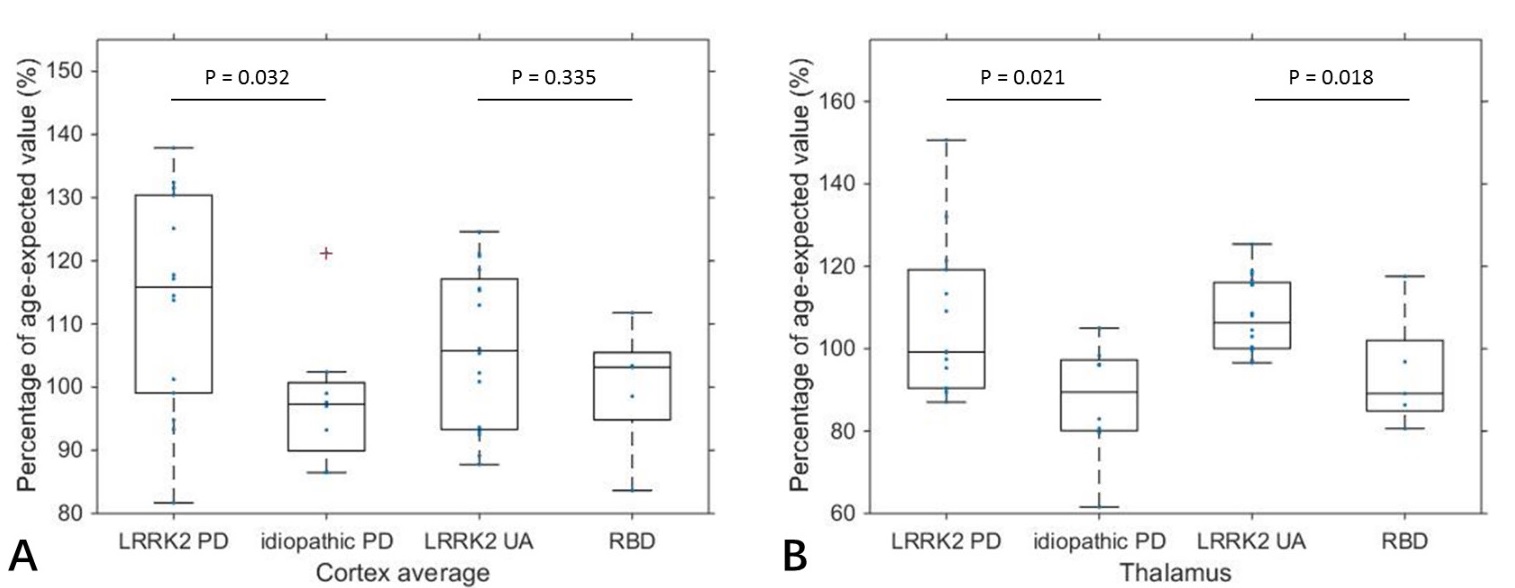Session Information
Date: Thursday, June 8, 2017
Session Title: Parkinson's Disease: Neuroimaging And Neurophysiology
Session Time: 1:15pm-2:45pm
Location: Exhibit Hall C
Objective: To evaluate the effects of leucine-rich repeat kinase 2 (LRRK2) mutations on the central cholinergic system in both manifesting and non-manifesting carriers using PET and MRI.
Background: LRRK2-PD has been reported to result in slower progression of motor symptoms, lower prevalence of REM sleep behavior disorder (RBD), less cognitive decline and better olfactory performance compared to idiopathic PD. Previous PET studies have suggested increased dopamine turn-over and preserved serotonergic innervation, but the influence of LRRK2 mutations on the central cholinergic system has never been examined.
Methods: 14 LRRK2-PD patients, 16 non-manifesting LRRK2 mutation carriers, 8 idiopathic PD patients, 5 idiopathic RBD patients and 11 controls underwent N-11C-methyl-piperidin-4-yl propionate PET scans. Acetylcholinesterase (AChE) hydrolysis rates were calculated using the striatal input method; age-expected control values for LRRK2-subjects, idiopathic PD and RBD subjects were derived from linear regression analyses of AChE hydrolysis rates on age performed in healthy control subjects. Voxel-based morphometry was conducted to control for a possibly difference in brain atrophy.
Results: We found significantly increased thalamic AChE hydrolysis rates in the non-manifesting LRRK2 mutation carriers compared to age-expected values (108.0 + 9.1%, P = 0.036). The increase of AChE activity was widespread through cortical regions in manifest stage (average cortex 113.6 + 17.2%, P = 0.015), especially in regions associated with default mode and limbic networks (113.2 + 17.4%, P = 0.013; 112.3 + 15.1%, P = 0.012); the increase was positively correlated with Hoehn & Yahr stage. Thalamic cholinergic activity was significantly decreased in idiopathic PD (93.3 + 8.8%, P = 0.033) and non-significantly decreased in RBD (94.1 + 14.4%, P = 0.338). Voxel-based morphometric analysis failed to detect any significant differences in gray matter volume between groups after family wise error correction.
Conclusions: LRRK2 mutation is associated with significantly increased cholinergic activity in the brain even in non-manifesting carriers and the effect is more prevalent through cortical regions once disease becomes manifest; while idiopathic PD or RBD is associated with decrease of cholinergic activity. Changes in cholinergic activity are unlikely to reflect the effects of atrophy.
To cite this abstract in AMA style:
S. [email protected], D. Wile, J. Fu, J. Valerio, E. Shahinfard, S. McCormick, R. Mabrouk, N. Vafai, J. McKenzie, N. Neilson, A. Perez-Soriano, J. Arena, M. Cherkasova, J. Zhang, C. Zabetian, J. Aasly, Z. Wszolek, M. McKeown, V. Sossi, A. Stoessl. The influence of LRRK2 mutations on cholinergic system in manifest and prodromal stage of Parkinson’s disease: a positron emission tomography study [abstract]. Mov Disord. 2017; 32 (suppl 2). https://www.mdsabstracts.org/abstract/the-influence-of-lrrk2-mutations-on-cholinergic-system-in-manifest-and-prodromal-stage-of-parkinsons-disease-a-positron-emission-tomography-study/. Accessed January 7, 2026.« Back to 2017 International Congress
MDS Abstracts - https://www.mdsabstracts.org/abstract/the-influence-of-lrrk2-mutations-on-cholinergic-system-in-manifest-and-prodromal-stage-of-parkinsons-disease-a-positron-emission-tomography-study/

